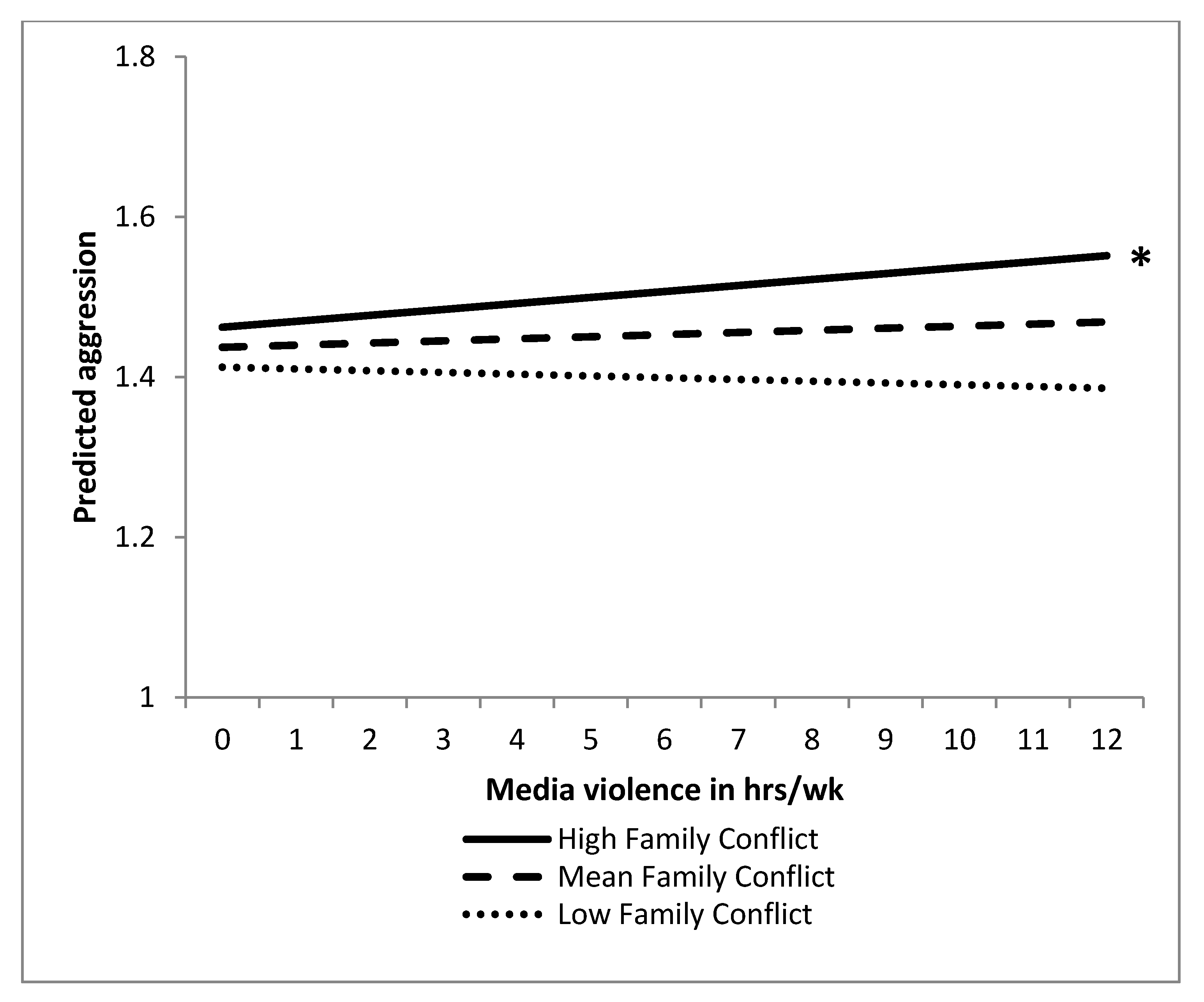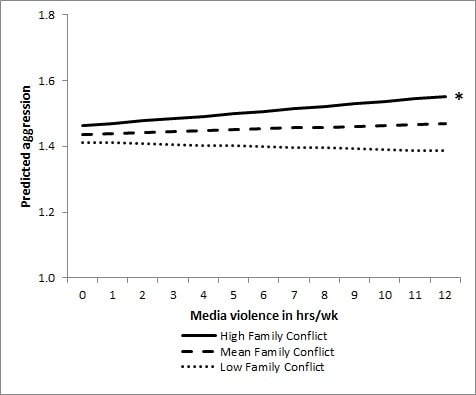Double Dose: High Family Conflict Enhances the Effect of Media Violence Exposure on Adolescents’ Aggression
Abstract
:1. Introduction
1.1. Research into Media Violence and Family Conflict
1.2. Theoretical Background
2. Method
2.1. Participants
2.2. Measures
2.2.1. Media Violence Exposure
2.2.2. Family Conflict
2.2.3. Aggression
2.3. Analytic Approach
3. Results
3.1. Descriptives and Intercorrelations
| Variables | Means (SD) | Correlations | ||||||
|---|---|---|---|---|---|---|---|---|
| Full sample | Boys | Girls | 1 | 2 | 3 | 4 | 5 | |
| 1. Aggression T1 | 1.52 (0.71) | 1.70 (0.82) | 1.32 (0.51) | - | ||||
| 2. Media violence T1 | 4.82 (8.30) | 7.60 (10.47) | 1.80 (2.71) | 0.27 *** | - | |||
| 3. Family conflict T1 | 2.10 (0.55) | 2.13 (0.55) | 2.07 (0.54) | 0.36 *** | 0.11 * | - | ||
| 4. Aggression T2 | 1.46 (0.68) | 1.61 (0.77) | 1.29 (0.51) | 0.55 *** | 0.18 *** | 0.30 *** | - | |
| 5. Gender a | - | - | - | 0.27 *** | 0.35 *** | 0.06 | 0.24 *** | - |
3.2. Main Effects of Media Violence and Family Conflict
| Parameters | Main effects | Two-way interaction | ||||
|---|---|---|---|---|---|---|
| b | SE | 95% CI | b | SE | 95% CI | |
| Regression coefficients (fixed effects) | ||||||
| Intercept | 1.46 *** | 0.03 | [1.40; 1.51] | 1.45 *** | 0.03 | [1.40; 1.50] |
| Aggression Time 1 | 0.47 *** | 0.04 | [0.39; 0.55] | 0.46 *** | 0.04 | [0.38; 0.54] |
| MVE | 0.00 | 0.00 | [−0.00; 0.01] | 0.00 | 0.00 | [−0.00; 0.01] |
| FC | 0.15 ** | 0.05 | [0.05; 0.25] | 0.14 ** | 0.05 | [0.04; 0.24] |
| MVE * FC | - | - | - | 0.01 * | 0.01 | [0.00; 0.03] |
| Variance components (random effects) | ||||||
| Random intercept | 0.04 † | 0.02 | [0.01; 0.12] | 0.04 † | 0.02 | [0.01; 0.12] |
3.3. Interaction between Media Violence and Family Conflict

4. Discussion
Limitations
5. Conclusion
Acknowledgments
Conflict of Interest
References
- Anderson, C.A.; Shibuya, A.; Ihori, N.; Swing, E.L.; Bushman, B.J.; Sakamoto, A.; Rothstein, H.R.; Saleem, M. Violent video game effects on aggression, empathy, and prosocial behavior in Eastern and Western countries: A meta-analytic review. Psychol. Bull. 2010, 136, 151–173. [Google Scholar] [CrossRef]
- Bushman, B.J.; Huesmann, L.R. Short-term and long-term effects of violent media on aggression in children and adults. Arch. Pediatr. Adolesc. Med. 2006, 160, 348–352. [Google Scholar] [CrossRef]
- Valkenburg, P.M.; Peter, J. Five challenges for the future of media-effects research. Int. J. Comm. 2013, 7, 197–215. [Google Scholar]
- Browne, K.D.; Hamilton-Giachritsis, C. The influence of violent media on children and adolescents: A public-health approach. Lancet 2005, 365, 702–710. [Google Scholar]
- Ribeaud, D.; Eisner, M. Risk factors for aggression in pre-adolescence: Risk domains, cumulative risk and gender differences—Results from a prospective longitudinal study in a multi-ethnic urban sample. Eur. J. Criminol. 2010, 7, 460–498. [Google Scholar] [CrossRef]
- Bandura, A. Social cognitive theory of mass communication. In Media Effects: Advances in Theory and Research; Bryant, J., Oliver, M.B., Eds.; Routledge: New York, NY, USA, 2009; pp. 94–123. [Google Scholar]
- White House. Available online: http://www.whitehouse.gov/photos-and-video/video/2013/01/16/president-obama-introduces-plan-reduce-gun-violence/ (accessed on 21 February 2013).
- Common Sense Media. Media and violence: An analysis of current research. 2013. Available online: http://www.commonsensemedia.org/research/media-and-violence-an-analysis-of-current-research/ (accessed on 18 February 2013).
- Moos, R.H.; Moos, B.S. Family Environment Scale Manual, 3rd ed.; Consulting Psychologist Press: Palo Alto, CA, USA, 1994. [Google Scholar]
- Bandura, A. Social Foundations of Thought and Action: A Social Cognitive Theory; Prentice Hall: Englewood Cliffs, NJ, USA, 1986. [Google Scholar]
- Ferguson, C.J. Media violence effects: Confirmed truth or just another X-File? J. Forensic Psychol. Pract. 2009, 9, 103–126. [Google Scholar] [CrossRef]
- Tanaka, A.; Raishevich, N.; Scarpa, A. Family conflict and childhood aggression: The role of child anxiety. J. Interpers. Violence 2010, 25, 2127–2143. [Google Scholar] [CrossRef]
- Vandewater, E.; Lansford, J. Influences of family structure and parental conflict on children’s well-being. Fam. Relat. 1998, 47, 323–330. [Google Scholar] [CrossRef]
- Gentile, D.A.; Coyne, S.; Walsh, D.A. Media violence, physical aggression, and relational aggression in school age children: A short-term longitudinal study. Aggress. Behav. 2011, 37, 193–206. [Google Scholar] [CrossRef]
- Krahé, B.; Möller, I. Longitudinal effects of media violence on aggression and empathy among German adolescents. J. Appl. Dev. Psychol. 2010, 31, 401–409. [Google Scholar] [CrossRef]
- Vandewater, E.; Lee, J.; Shim, M. Family conflict and violent electronic media use in school-aged children. Media Psychol. 2005, 7, 73–86. [Google Scholar] [CrossRef]
- Ferguson, C.J.; San Miguel, C.; Hartley, R.D. A multivariate analysis of youth violence and aggression: The influence of family, peers, depression, and media violence. J. Pediatr. 2009, 155, 904–908. [Google Scholar] [CrossRef]
- Huesmann, L.R.; Moise-Titus, J.; Podolski, C.; Eron, L.D. Longitudinal relations between children’s exposure to TV violence and their aggressive and violent behavior in young adulthood: 1977–1992. Dev. Psychol. 2003, 39, 201–221. [Google Scholar] [CrossRef]
- Jordan, A. The role of media in children's development: An ecological perspective. J. Dev. Behav. Pediatr. 2004, 25, 196–206. [Google Scholar] [CrossRef]
- Slater, M.D.; Snyder, L.; Hayes, A.F. Thinking and modeling at multiple levels: The potential contribution of multilevel modeling to communication theory and research. Hum. Commun. Res. 2006, 32, 375–384. [Google Scholar] [CrossRef]
- Gerbner, G.; Gross, L.; Morgan, M.; Signorielli, N. The mainstreaming of America: Violence profile no. 11. J. Commun. 1980, 30, 10–29. [Google Scholar]
- Valkenburg, P.M.; Peter, J. The differential susceptibility to media effects model. J. Commun. 2013, 64, 221–243. [Google Scholar] [CrossRef]
- Anderson, C.A.; Bushman, B.J. Human aggression. Annu. Rev. Psychol. 2002, 53, 27–51. [Google Scholar] [CrossRef]
- Huesmann, L.R. The impact of electronic media violence: Scientific theory and research. J. Adolesc. Health 2007, 41, S6–S13. [Google Scholar] [CrossRef]
- Farver, J.A.M.; Xu, Y.Y.; Eppe, S.; Fernandez, A.; Schwartz, D. Community violence, family conflict, and preschoolers' socioemotional functioning. Dev. Psychol. 2005, 41, 160–170. [Google Scholar] [CrossRef]
- Margolin, G.; Gordis, E.B. The effects of family and community violence on children. Annu. Rev. Psychol. 2000, 51, 445–479. [Google Scholar] [CrossRef]
- McKelvey, L.M.; Whiteside-Mansell, L.; Bradley, R.H.; Casey, P.H.; Conners-Burrow, N.A.; Barrett, K.W. Growing up in violent communities: Do family conflict and gender moderate impacts on adolescents’ psychosocial development? J. Abnorm. Child Psychol. 2011, 39, 95–107. [Google Scholar] [CrossRef]
- Proctor, L.J. Children growing up in a violent community: The role of the family. Aggress. Violent Beh. 2006, 11, 558–576. [Google Scholar] [CrossRef]
- Huesmann, L.R.; Guerra, N.G. Children’s normative beliefs about aggression and aggressive behavior. J. Pers. Soc. Psychol. 1997, 72, 408–419. [Google Scholar] [CrossRef]
- Perry, D.G.; Perry, L.C.; Rasmussen, P. Cognitive social-learning mediators of aggression. Child Dev. 1986, 57, 700–711. [Google Scholar] [CrossRef]
- Orue, I.; Bushman, B.J.; Calvete, E.; Thomaes, S.; Orobio de Castro, B.; Hutteman, R. Monkey see, monkey do, monkey hurt: Longitudinal effects of exposure to violence on children's aggressive behavior. Soc. Psychol. Person. Sci. 2011, 2, 432–437. [Google Scholar] [CrossRef]
- Anderson, K.R.; Cavallaro, D. Parents or pop culture? Children’s heroes and role models. Childhood Educ. 2002, 78, 161–168. [Google Scholar] [CrossRef]
- Bricheno, P.; Thornton, M. Role model, hero or champion? Children’s views concerning role models. Educ. Res. 2007, 49, 383–396. [Google Scholar] [CrossRef]
- Duncan, S.C.; Strycker, L.A.; Duncan, T.E.; Okut, H. A multilevel contextual model of family conflict and deviance. J. Psychopathol. Behav. 2002, 24, 169–175. [Google Scholar] [CrossRef]
- Formoso, D.; Gonzales, N.A.; Aiken, L.S. Family conflict and children’s internalizing and externalizing behavior: Protective factors. Am. J. Community Psychol. 2000, 28, 175–199. [Google Scholar] [CrossRef]
- Rideout, V.J.; Foehr, U.G.; Roberts, D.F. Generation M2. Media in the Lives of 8- to 18-Year-Olds. 2010. Available online: http://kff.org/other/poll-finding/report-generation-m2-media-in-the-lives/ (accessed on 14 December 2011).
- Konijn, E.A.; Nije Bijvank, M.; Bushman, B.J. I wish I were a warrior: The role of wishful identification in the effects of violent video games on aggression in adolescent boys. Dev. Psychol. 2007, 43, 1038–1044. [Google Scholar] [CrossRef]
- Boyatzis, C.J.; Matillo, G.M.; Nesbitt, K.M. Effects of the "Mighty Morphin Power Rangers" on children’s aggression with peers. Child Study J. 1995, 25, 45–55. [Google Scholar]
- Vandewater, E.A.; Lee, S. Measuring children’s media use in the digital age: Issues and challenges. Am. Behav. Sci. 2009, 52, 1152–1176. [Google Scholar] [CrossRef]
- Lee, C.; Hornik, R.; Hennessy, M. The reliability and stability of general media exposure measures. Commun. Methods Meas. 2008, 2, 6–22. [Google Scholar] [CrossRef]
- Schmitz, K.H.; Harnack, L.; Fulton, J.E.; Jacobs, D.R.; Gao, S.; Lytle, L.A.; van Coevering, P. Reliability and validity of a brief questionnaire to assess television viewing and computer use by middle school children. J. School Health 2004, 74, 370–377. [Google Scholar] [CrossRef]
- Jansma, J.B.M.; Coole, R.L. GKS-II, Gezins Klimaat Schaal. Handleiding; Swets & Zeitlinger: Lisse, The Netherlands, 1996. [Google Scholar]
- Björkqvist, K.; Lagerspetz, K.M.J.; Kaukiainen, A. Do girls manipulate and boys fight? Developmental trends in regard to direct and indirect aggression. Aggress. Behav. 1992, 18, 117–127. [Google Scholar] [CrossRef]
- Hayes, A.F. A primer on multilevel modeling. Hum. Commun. Res. 2006, 32, 385–410. [Google Scholar] [CrossRef]
- Desai, M.; Begg, M.D. A comparison of regression approaches for analyzing clustered data. Am. J. Public Health 2008, 98, 1425–1429. [Google Scholar] [CrossRef]
- Hopf, W.H.; Huber, G.L.; Weiss, R.H. Media violence and youth violence: A 2-year longitudinal study. J. Media Psychol. 2008, 20, 79–96. [Google Scholar] [CrossRef]
- Krahé, B.; Busching, R.; Möller, I. Media violence use and aggression among German adolescents: Associations and trajectories of change in a three-wave longitudinal study. Psychol. Popular Media Cult. 2012, 1, 152–166. [Google Scholar] [CrossRef]
- Preacher, K.J.; Curran, P.J.; Bauer, D.J. Computational tools for probing interaction effects in multiple linear regression, multilevel modeling, and latent curve analysis. J. Educ. Behav. Stat. 2006, 31, 437–448. [Google Scholar] [CrossRef]
- Bauer, D.J.; Curran, P.J. Probing interactions in fixed and multilevel regression: Inferential and graphical techniques. Multivar. Behav. Res. 2005, 40, 373–400. [Google Scholar] [CrossRef]
- Lösel, F.; Bliesener, T.; Bender, D. Social information processing, experiences of aggression in social contexts, and aggressive behavior in adolescents. Crim. Justice Behav. 2007, 34, 330–347. [Google Scholar] [CrossRef]
- Henry, D.; Guerra, N.; Huesmann, R.; Tolan, P.; VanAcker, R.; Eron, L. Normative influences on aggression in urban elementary school classrooms. Am. J. Community Psychol. 2000, 28, 59–81. [Google Scholar] [CrossRef]
- Schultz, D.; Shaw, D.S. Boys’ maladaptive social information processing, family emotional climate, and pathways to early conduct problems. Soc. Dev. 2003, 12, 440–460. [Google Scholar] [CrossRef]
- Van der Voort, T.H.A.; Vooijs, M.W. Validity of children’s direct estimates of time spent television viewing. J. Broadcast. Electron 1990, 34, 93–99. [Google Scholar] [CrossRef]
- Robinson, J.P.; Godbey, G. Time for Life: The Surprising Ways Americans Use Their Time; Pennsylvania State University Press: University Park, PA, USA.
- Anderson, C.A.; Dill, K.E. Video games and aggressive thoughts, feelings, and behavior in the laboratory and in life. J. Pers. Soc. Psychol. 2000, 78, 772–790. [Google Scholar] [CrossRef]
© 2013 by the authors; licensee MDPI, Basel, Switzerland. This article is an open access article distributed under the terms and conditions of the Creative Commons Attribution license (http://creativecommons.org/licenses/by/3.0/).
Share and Cite
Fikkers, K.M.; Piotrowski, J.T.; Weeda, W.D.; Vossen, H.G.M.; Valkenburg, P.M. Double Dose: High Family Conflict Enhances the Effect of Media Violence Exposure on Adolescents’ Aggression. Societies 2013, 3, 280-292. https://doi.org/10.3390/soc3030280
Fikkers KM, Piotrowski JT, Weeda WD, Vossen HGM, Valkenburg PM. Double Dose: High Family Conflict Enhances the Effect of Media Violence Exposure on Adolescents’ Aggression. Societies. 2013; 3(3):280-292. https://doi.org/10.3390/soc3030280
Chicago/Turabian StyleFikkers, Karin M., Jessica Taylor Piotrowski, Wouter D. Weeda, Helen G. M. Vossen, and Patti M. Valkenburg. 2013. "Double Dose: High Family Conflict Enhances the Effect of Media Violence Exposure on Adolescents’ Aggression" Societies 3, no. 3: 280-292. https://doi.org/10.3390/soc3030280





